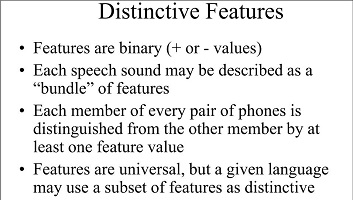Distinctive features in Phonology/explanation
Distinctive features
Distinctive features in Phonology is very important to understand. These are the most important features to elaborate the sound system in a language. Distinctive features in Phonology

We said above that some groups of sounds behave the same in the same phonetic environment. We can divide sounds into groups based on their > phonological characteristics . Sounds that belong to the same > natural class behave the same in the same environment. The phonological features are sometimes called > distinguishing features . These characteristics make the difference between phonemes. For example, the / d / and the / n / are both alveolar and both voting. Yet they are not the same phoneme. This is because the / n / nasal is and the / d / not. The distinguishing characteristic between these two sounds is therefore the NASAL characteristic. This distinctive feature alone makes the difference between the words/ to / and / there / .
We already have two distinctive features. One is the STEM attribute. If your vocal cords vibrate during the production of a sound, we say that this sound has the characteristic [+ STEM]. The other characteristic is NASAL. The / n / is [+ NASAL] and the / d / is [-NASAL]. We need two more features. We can then distinguish many consonants from each other on the basis of distinctive characteristics. These two characteristics have the difficult names CONTINUANT and LATERAL. If, when producing a sound, the air is blocked somewhere in the oral cavity, this sound is [-CONT]. If the air is not blocked, the sound is [+ CONT]. In Dutch, only the [l] is lateral, so [+ LAT]. This means that the air escapes along the sides of the oral cavity, because the tongue blocks the middle. Distinctive features in Phonology
We can describe many Dutch consonants with the help of these four distinguishing characteristics:
| p | b | t | d | k | f | v | s | z | X | m | n | l | r | ʀ | υ | j | h | |
| VOICE | – | + | – | + | – | – | + | – | + | – | + | + | + | + | + | + | + | + |
| NASAL | – | – | – | – | – | – | – | – | – | – | + | + | – | – | – | – | – | – |
| CONT | – | – | – | – | – | + | + | + | + | + | + | + | + | + | + | + | + | + |
| LAT | – | – | – | – | – | – | – | – | – | – | – | – | + | – | – | – | – | – |
This list is not complete. First, there are many more consonants in Dutch, for example [ ɣ ], [ ʃ ] and [ ʒ ] and more. Secondly, there are many more distinguishing features. Most phonology books mention about 14, including VELAIR and LABIAL. These characteristics must appear familiar to you! Just look in the chapter on phonetics.
We can now explain a number of phonological processes .
First, we can designate a number of > natural classes . For example, only / p /, / t / and / k / have the attributes [-STEM], [-NAS] and [-CONT] (see if this is correct!). Together they form the natural class of the voiceless plosives. So we can now say that in English aspiration occurs in the natural class of voiceless plosives. In other words: in English, voiceless plosives get aspiration at the start of a word.
Sounds can belong to several natural classes. The / p /, for example, also belongs to the labial class, along with / m /, / b /, / f /, / v / and / υ /. (Note: both bilabial and labiodental sounds are part of this.) This class plays a role in a phonological rule of Dutch that we will discuss below.
A language has hundreds of sounds. With the help of the distinguishing features we can describe these sounds much easier. There are approximately 40 phonemes in Dutch. All other sounds are predictable. They are the result of phonological rules. For example, the / i / in Dutch is longer for an / r /, if in / beer / , than for a / t /, if in / beet / . In Dutch, all vowels are longer for a / r /. This difference in sound, the length of the vowel, is therefore predictable. It is a consequence of the phonological rules of the Dutch language. Distinctive features in Phonology
As with syntax, we have found structure in our language. All variation, hundreds of sounds, are the result of a limited number of rules


